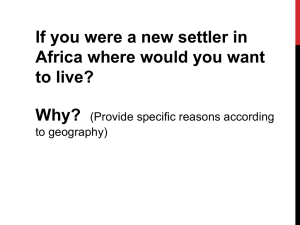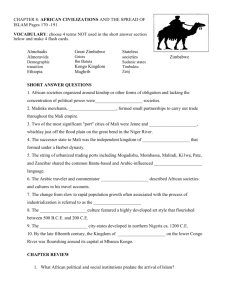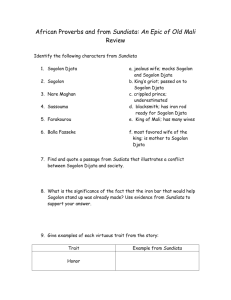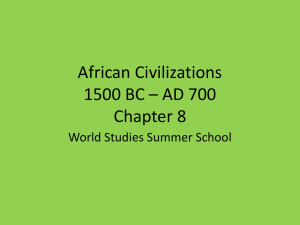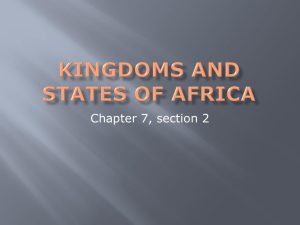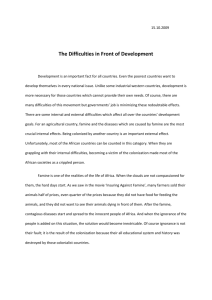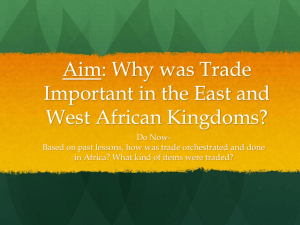Answer in complete sentences
advertisement
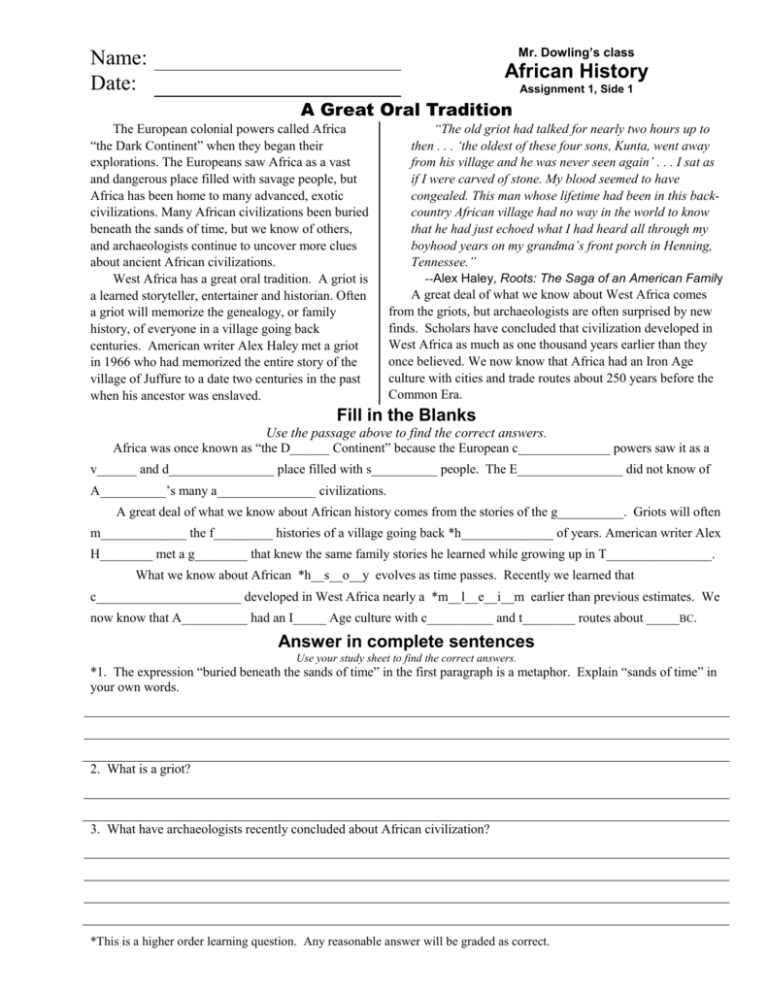
Mr. Dowling’s class Name: Date: African History Assignment 1, Side 1 A Great Oral Tradition The European colonial powers called Africa “the Dark Continent” when they began their explorations. The Europeans saw Africa as a vast and dangerous place filled with savage people, but Africa has been home to many advanced, exotic civilizations. Many African civilizations been buried beneath the sands of time, but we know of others, and archaeologists continue to uncover more clues about ancient African civilizations. West Africa has a great oral tradition. A griot is a learned storyteller, entertainer and historian. Often a griot will memorize the genealogy, or family history, of everyone in a village going back centuries. American writer Alex Haley met a griot in 1966 who had memorized the entire story of the village of Juffure to a date two centuries in the past when his ancestor was enslaved. “The old griot had talked for nearly two hours up to then . . . ‘the oldest of these four sons, Kunta, went away from his village and he was never seen again’ . . . I sat as if I were carved of stone. My blood seemed to have congealed. This man whose lifetime had been in this backcountry African village had no way in the world to know that he had just echoed what I had heard all through my boyhood years on my grandma’s front porch in Henning, Tennessee.” --Alex Haley, Roots: The Saga of an American Family A great deal of what we know about West Africa comes from the griots, but archaeologists are often surprised by new finds. Scholars have concluded that civilization developed in West Africa as much as one thousand years earlier than they once believed. We now know that Africa had an Iron Age culture with cities and trade routes about 250 years before the Common Era. Fill in the Blanks Use the passage above to find the correct answers. Africa was once known as “the D______ Continent” because the European c______________ powers saw it as a v______ and d________________ place filled with s__________ people. The E________________ did not know of A__________’s many a_______________ civilizations. A great deal of what we know about African history comes from the stories of the g__________. Griots will often m_____________ the f_________ histories of a village going back *h______________ of years. American writer Alex H________ met a g________ that knew the same family stories he learned while growing up in T________________. What we know about African *h__s__o__y evolves as time passes. Recently we learned that c______________________ developed in West Africa nearly a *m__l__e__i__m earlier than previous estimates. We now know that A__________ had an I_____ Age culture with c__________ and t________ routes about _____BC. Answer in complete sentences Use your study sheet to find the correct answers. *1. The expression “buried beneath the sands of time” in the first paragraph is a metaphor. Explain “sands of time” in your own words. 2. What is a griot? 3. What have archaeologists recently concluded about African civilization? *This is a higher order learning question. Any reasonable answer will be graded as correct. Mr. Dowling’s class Name: Date: African History Assignment 1, Side 2 The Nok In 1928, archaeologists unearthed artifacts from an amazing culture that flourished from about 500BC to AD200. The archaeologists referred to the ancient culture as Nok, the name of a modern Nigerian village where they made their discovery. Nok artifacts included sculptures of animals and people made of terra cotta. Terra cotta is clay that has been baked in an oven. The complex Nok sculptures were probably based on woodcarvings, but any wooden artifacts would have disintegrated long ago in the humid climate of West Africa. This leads archaeologists to believe that the Nok civilization may have been much older than even the oldest artifact. The Nok discovered that they were able to “smelt” iron by heating certain rocks to a high temperature. Iron is very malleable. A malleable material can be reshaped, and the Nok used iron to make weapons and plows. Most ancient cultures discovered other metals such as copper and bronze before iron, but the Nok apparently moved directly from the Stone Age to the Iron Age without having a Copper or Bronze Age. Fill in the Blanks Use the passage above to find the correct answers. In 1928, a__c__a__o__o__i__ts uncovered an ancient *unn__m__d civilization in the present day village of N____, Nigeria. The ancient Nok c__l__u__e apparently flourished for at least *____ years. The artifacts of the region included figurines made of t________ c________, or clay that has baked in an o______. The s________________________ of the figurines lead archaeologists to believe the N____ culture was even o__d__r than the oldest *s__u__p____re. The a____________ Nok culture s____________ iron by h____________ rocks to a high t__m__e__a__u__e. Iron can be r__s__a__ed to make w____________ and p________. Iron can also be used for cooking and heating because it conducts heat well. The Nok apparently moved from the S________ to the I______ Age. Most cultures discovered c__________ and b__________ before iron. We don’t know if the Nok discovered the secrets of i______ on their own, or if they learned about it from another c__l__u__e. Answer in complete sentences Please write in complete sentences. 4. The ancient Nok culture existed at the confluence of the Niger and Benue rivers. Use a dictionary to find the meaning of confluence. 5. Why do we refer to an ancient African civilization as the Nok? *6. Why do archaeologists believe that the Nok civilization may have been much older than its oldest artifact? *7. List five tools or weapons made from iron that would advance an ancient civilization. *This is a higher order learning question. Any reasonable answer will be graded as correct. Mr. Dowling’s class Name: Date: African History Assignment 2, Side 1 Trade The civilizations that flourished in ancient West Africa were all based on trade, so successful West African leaders tended to be peacemakers rather than warriors. Caravans from North Africa crossed the Sahara beginning in the seventh century of the Common Era. Gold from West Africa was exchanged for something the West Africans prized even more: salt. Salt was used as a flavoring, a food preservative, and for retaining body moisture. The first people to make the trek across the Sahara were the Berbers of North Africa who brought their strict Islamic faith across the desert. The Berbers converted many of the merchants of West Africa to Islam, but most of the common people retained their traditional beliefs. The ancient West Africans, like Native Americans and the Sumerians, believed that many gods existed in nature. They did not accept the Muslim belief in one God. THE PEOPLE SOUTH OF THE SAHARA DESERT HAD LITTLE CONTACT WITH THE REST OF THE WORLD The Sahara Desert is hot and dry. It was almost impossible to cross without modern transportation. The few rivers that flow from sub-Saharan Africa contain many high waterfalls that make travel difficult. Both the sub-Saharan Africans and the people north of the desert were fearful of venturing into the ocean. The tsetse flies that live on the edge of the Sahara Desert carry deadly diseases. Answer in complete sentences Use your study sheet to find the correct answers. *8. Why did West Africans tend to be conciliators rather than warriors? 9. Explain why many people in ancient West Africa valued salt more than gold. 10. Write a paragraph that explains why paragraph that explains why people south of the Sahara Desert had little contact with the rest of the world. Your paragraph must include a topic sentence, at least two support sentences, and a conclusion that restates but does not repeat the topic sentence. *This is a higher order learning question. Any reasonable answer will be graded as correct. Mr. Dowling’s class Name: Date: African History Assignment 2, Side 2 Sundiata The griots of West Africa still tell the 700-year-old story of a sickly boy named Sundiata, who grew up to become a great warrior, defeated a brutal enemy, and united the Mandinka people. Samanguru was a tyrant who ruled the small state of Kaniaga, but he managed to conquer a great deal of West Africa. Samanguru was hostile to the Mandinka people who lived in that area. His taxes were high, he felt it was his privilege to carry off Mandinka women, and he failed to maintain law and order along the trade routes that once prospered in West Africa. Sundiata was one of twelve sons of a Mandinka warrior. Samanguru killed Sundiata’s brothers, but spared the future warrior because he believed the boy sickly and Samanguru believed Sundiata would soon die anyway. That mistake would lead to Samanguru’s downfall. The ill child recovered and eventually assembled an army to confront Samanguru. Sundiata’s forces killed Samanguru and destroyed his forces in the Battle of Kirina in 1235. Sundiata then became mansa, or king, of a new empire that we know today as Mali. Mali means “where the king resides.” Sundiata proved himself to be a great warrior, but he was less interested in power than in once again making West Africa a safe place to travel and trade. Most merchants and traders in West Africa at that time practiced Islam. Sundiata converted to Islam, but only as a gesture of goodwill to the merchants and traders. To his own people, Sundiata presented himself as a champion of traditional West African religion. Fill in the Blanks Use the passage above to find the correct answers. Samanguru was a hostile w__r__i__r in thirteenth century West Africa. He mistreated the local M______________ people and f__________ to maintain l____ and o________ along West Africa’s t________ routes. Sundiata was the warrior who defeated S__m__n__u__u. Sundiata was born a s__________ child. Samanguru k__________ Sundiata’s t__________ brothers, but spared Sundiata because he believed the child would soon d____ anyway. Sundiata r________________, and eventually assembled an a______ to confront the *k__l__er of his *b__o__h__rs. Sundiata killed Samanguru *____ years ago in the B________ of K__________. Sundiata then became the king, or m________ of a new empire we know today as M______. Sundiata ensured that Mali was a s______ place to t__________ and t________. He converted to I_________, but presented himself as a champion of t____________________ West African religion to the common people of M______. Answer in complete sentences Please write in complete sentences. *11. How do we know about the legend of Sundiata? How was it passed down from 1235 to today? 12. What was Sundiata’s primary interest as the mansa of Mali? *This is a higher order learning question. Any reasonable answer will be graded as correct. zzz Mr. Dowling’s class Name: Date: African History Assignment 3, Side 1 Mansa Musa Mansa Musa captured the attention of the Arab world when he left his home in the West African kingdom of Mali to make a pilgrimage to Mecca in 1324. Unlike his grandfather Sundiata, Mansa Musa was a devout Muslim. A Muslim is a person who practices Islam. Islamic law requires that all faithful Muslims make a hajj, or holy visit, to the city on the Arabian Peninsula where Islam developed. Mansa Musa was a very rich king. He was said to have taken more than 500 people with him on the hajj, each carrying a staff of solid gold. When Mansa Musa passed through the Egyptian city of Cairo, legends say he gave away so much gold that the price of gold fell, and the economy was affected for more than twenty years. The appearance of a wealthy king from a faraway land made a deep impression on the people he encountered, causing Mali to appear on maps throughout the Middle East and Europe. For the first time, sub-Saharan Africa became well known north of the Sahara Desert. The kingdom of Mali eventually weakened, and the neighboring kingdom of Songhai developed into the last black empire of pre-colonial West Africa. Songhai was destroyed after a bloody war with Morocco. Morocco’s sultan wanted West African gold, so in 1590, he sent an army of 3000 men south across the Sahara Desert. The spears and lances of the Songhai warriors were no match for the cannons and muskets of the Moroccan army, but the fighting continued long after the Songhai government had been destroyed. After ten years, the Sultan lost interest and abandoned his army in Songhai. The Moroccan soldiers were either killed or absorbed into the local population. The Moroccan invasion destroyed Songhai and the trade routes that had brought prosperity to the region for hundreds of years. Fill in the Blanks Use the passage above to find the correct answers. Mansa Musa was a M__n__i__k__n (language group) *m__n__r__h (another word for king, but not mansa) from M______ (kingdom). He made a pilgrimage to M________ (Islamic holy city) because he was a M__________ (religious faith). Mansa M______ was both rich and generous. The legends say he took more than ______ people with him, each carrying a s________ of solid g______. When M________ Musa passed through the E______________ city of Cairo, he gave away so much gold that the p________ fell and the e____________ was affected for more than t__________ years. The w__________ of Mansa M______ caught the attention of the rest of the world. Soon, M______ began to appear on m______ throughout the Middle E______ and E__________. M________ Musa’s successors were less able, and in time, M______ was replaced by another k____________ named S____________. Songhai flourished until fighting a bloody war with M____________. Three thousand Moroccan s______________ crossed the d__________ in 15____. They were badly outnumbered, but the s________ and l__________ of the S____________ warriors were no match for the c__________ and m____________ of the Moroccan army. The two sides fought for more than t____ years, until the S__________ lost i______________ and a________________ his a______ in S____________. The Moroccan i______________ was unsuccessful, but it destroyed S____________ the t________ routes that brought p__________________ to West Africa for hundreds of years. *This is a higher order learning question. Any reasonable answer will be graded as correct. Mr. Dowling’s class Name: Date: African History Assignment 3, Side 2 Answer in complete sentences Please write in complete sentences. 13. How was Mansa Musa’s religious faith different from that of Sundiata? *14. Explain why the price of gold fell after Mansa Musa passed through Cairo? 15. What kingdom replaced Mali in West Africa? 16. How was Songhai destroyed? 17. Why were the warriors of Songhai outmatched despite having a larger army than Morocco? *18. Why didn’t another kingdom develop in West Africa after the fall of Songhai? *This is a higher order learning question. Any reasonable answer will be graded as correct. Mr. Dowling’s class Name: Date: African History Assignment 4, Side 1 Aksum Aksum (also spelled Axum) is today a rural and easily overlooked town in northern Ethiopia, but for more than six hundred years, Aksum was a center of trade and the site where Christianity was first introduced to sub Saharan Africa. Aksum’s wealth was derived from its location on the Red Sea. Aksumites exchanged spices, ivory, ebony and animal shells with Egypt, Greece, Rome and lands as far away as Persia and India. Foreign ships introduced textiles, precious metal objects, wine and olive oil to East Africa through the ports in the Aksumite kingdom. Gold and silver coins minted in Aksum circulated in Africa, Asia and Europe from about AD270 to the empire’s decline in the seventh century. The coins spread the message of Aksum’s wealth. Modern historians are able to use the coins to provide a reliable history of the Aksumite Empire. Aksumite kings used their wealth to build impressive palaces and granite monuments. Local legends describe how two shipwrecked brothers brought Christianity to Aksum in the fourth century. Frumentius and Aedesius were aboard a ship that stopped to rest during a voyage. Local tribes people massacred everyone onboard the ship except for the two brothers, who were taken as slaves to the Aksumite king and queen. When the king died, Frumentius and Aedesius gained the favor of the queen. She asked the brothers to tutor her son, Ezana, and to assist her in running the empire. The brothers encouraged traveling Christian merchants to share their faith, and in time, the boy they tutored became king. King Ezana established the Ethiopian Orthodox Church in the fourth century. Islam became the dominant religion in the Middle East and North Africa beginning in the seventh century, but more than forty million people in Ethoipia continue to practice Christianity today. The Aksumite Empire began a slow decline that began in the seventh century of the Common Era. Aksum remained a Christian stronghold while Islam spread throughout the Middle East and North Africa. Muslim traders often found it easier to exchange goods with cultures that shared their faith. Further, over farming exhausted the land, forcing many Axumites to move further inland in order to grow crops. A changing climate caused the land to become warmer and drier. Also, the flood pattern of the Nile changed after the seventh century. These factors led cultures in the region to bypass Aksum in order to trade with one another directly. Answer in complete sentences Please write in complete sentences. 19. Explain how Aksum’s location helped it to become a wealthy city. 20. The text states that “Modern historians are able to use the coins to provide a reliable history of the Aksumite Empire.” How do you think coins might help historians understand an ancient culture? 21. Describe at least two factors that led to the fall of Aksum as a major trading culture. *This is a higher order learning question. Any reasonable answer will be graded as correct. Mr. Dowling’s class Name: Date: African History Assignment 4, Side 2 Timbuktu No name brings ancient Africa to mind more than Timbuktu, a great city that flourished on a bend in the Niger River for more than four hundred years. Timbuktu was at the end of the camel caravan route that linked sub-Saharan Africa to North Africa and Arabia. Gold, ivory and kola nuts passed through Timbuktu, but the most important commodity was salt. Timbuktu was located near several salt mines in the Sahara Desert. Caravans hauled salt from the mines to trade for gold. Timbuktu began as a trading city, but in time it developed into the educational and spiritual center of West Africa. By 1330, Timbuktu became part of the kingdom of Mali. Mansa Musa built a great mosque, or Islamic temple, in Timbuktu. The mosque attracted scholars from as far away as Saudi Arabia. Timbuktu began to decline in influence when the Portuguese showed that it was easier to sail along the coast of Africa than travel through the desert. The city was destroyed at the end of the sixteenth century by the war between Morocco and Songhai. At one time, historians estimate that more than 100,000 people lived in Timbuktu, but today it remains a shadow of its former self, a mud-built town of 20,000 people on the edge of the Sahara Desert. Fill in the Blanks Use the passage above to find the correct answers. Today Timbuktu is a small t______ on the e________ of the S__________ Desert, but it was the greatest t____________ city in sub-Saharan Africa for more than four h____________ years. Timbuktu was l____________ on a b______ in the N________ River. Traders would mine s______ in the nearby d__________ and carry it to T______________. Merchants in the city would then *t__a__s__o__t the salt to far away places. Timbuktu was also known as an *i__t__ll__ct__al and r_______________ site. Mansa Musa built a great m__________ in the city. Timbuktu’s influence began to d____________ when the P__________________ demonstrated that it was easier to s______ along the c________ of Africa than to t__________ through the d__________. The city was also damaged in the w____ between M____________ and S____________. Answer in complete sentences Please write in complete sentences. 19. How did the location of Timbuktu help it to become a great trading city? 20. How did Timbuktu differ from Aksum? 20. What was Timbuktu known for in addition to trade? 21. Why did Timbuktu decline in influence? *This is a higher order learning question. Any reasonable answer will be graded as correct. Mr. Dowling’s class Name: Date: African History Assignment 5, Side 1 Prince Henry the Navigator Prince Henry of Portugal was born almost 100 years before Columbus sailed to America. In Prince Henry’s time, very few people ventured far from shore, and Africa was a mysterious place that seemed to contain endless miles of sand. Today we know the Sahara Desert isn’t endless, but it is the world’s largest desert. On the other side of the Sahara were many great cultures that were isolated from the rest of the world. Prince Henry wanted to find a water route to India. The passage to India over land was long, slow and dangerous. A ship could carry more goods to and from India than the largest caravans, but Europeans could only guess that sailors could circumnavigate, or go around, Africa. Prince Henry seldom left his home, but he is known to history as Henry the Navigator because he helped make it possible for the first European sailors to explore Africa. Henry set up a school for sailors to learn the secrets of the ocean. He paid for many sailing expeditions out of the Portuguese treasury. Henry also employed cartographers and inventors who created the most sophisticated maps and navigational instruments of their time. Henry was a visionary. A visionary is someone who can imagine something that hasn’t yet happened. Henry owned a globe at a time when many people believed the world was flat. He knew that Africa was more than endless land, and that if his sailors could circumnavigate the continent, he would find a water route to India. When Henry died in 1460, his sailors had only reached as far as the Canary Islands off the coast of West Africa. Twenty-eight years later, Bartholomeu Dias proved that Africa could be circumnavigated when he reached the southern tip of the continent. In 1499, Vasco da Gama was the first sailor to travel from Portugal to India by sea. Just a few years earlier, Queen Isabella of Spain hired a sailor from Italy to reach India by sailing west. It wasn’t until years later that anyone understood that the “Indians” he encountered weren’t from India after all. Answer in complete sentences Please write in complete sentences. *22. Why was Prince Henry known as “the Navigator?” *23. Irony is the use of words to express something different from and often opposite to their literal meaning. Why was Prince Henry’s nickname ironic? *24. Describe something that would require you to use your visionary powers. *25. Why was it important to find a water route from Portugal to India? 26. Contrast the accomplishments of Bartholomeu Dias and Vasco daGama? *This is a higher order learning question. Any reasonable answer will be graded as correct. Mr. Dowling’s class Name: Date: African History Assignment 5, Side 2 The Missionaries Not all Europeans went to Africa to become rich. Many devout Christians traveled to Africa on missions to teach their religion. The missionaries did more than share their faith; they also taught the African people modern science and medicine. David Livingstone was the most famous African missionary. Livingstone was an Englishman who believed that the African slave trade could be destroyed through the influence of Christianity and by treating the African people with kindness and respect. After a four-month journey, Livingstone arrived in South Africa in 1841. Livingstone learned African languages and customs, and he explored a great portion of the continent. He believed the best way to share his faith with the Africans was to teach them about the outside world. Livingstone supported his missionary work by writing books about his travels. Livingstone was appalled by the way the Dutch and Portuguese colonists treated the African people. His writings told the world about the slave trade, which Livingstone called “the open sore of Africa.” Livingstone’s writing made him famous to the outside world, but by 1869, he had not been heard from for six years. The New York Herald newspaper sent reporter Henry Morton Stanley to find out what had happened to the famous missionary. Two years into his journey, Stanley is reported to have greeted a very ill Livingstone with the famous words, “Dr. Livingstone, I presume.” Stanley urged Livingstone to leave Africa, but the missionary felt his work was not complete. When Livingstone died in 1873, most of his body was returned to England, but the missionary’s many friends buried his heart in Africa. Answer in complete sentences Please write in complete sentences. *31. Why do you think David Livingstone was motivated to live in Africa? *32. Why do you think the people of nineteenth century bought Livingstone’s books? *33. Why do you think the New York Herald sent Henry Morton Stanley to find out what had happened to Livingstone? *34. Why do you think Livingstone’s heart is buried in Africa? *This is a higher order learning question. Any reasonable answer will be graded as correct.
